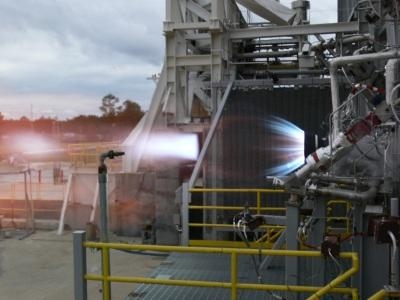Wed, Oct 17, 2012
Will Power Reusable Booster System To Lift Company's Biconic Space Vehicle
NASA's Commercial Crew Program (CCP) partner Blue Origin has successfully fired the thrust chamber assembly for its new 100,000 pound thrust BE-3 liquid oxygen, liquid hydrogen rocket engine. As part of Blue's Reusable Booster System (RBS), the engines are designed eventually to launch the biconic-shaped Space Vehicle the company is developing.

The test was part of Blue Origin's work supporting its funded Space Act Agreement with NASA during Commercial Crew Development Round 2 (CCDev2). CCDev2 continues to bring spacecraft and launch vehicle designs forward to develop a U.S. commercial crew space transportation capability that ultimately could become available for the government and other customers. "Blue Origin continues to be extremely innovative as it develops a crew-capable vehicle for suborbital and orbital flights," said Ed Mango, CCP manager. "We're thrilled the company's engine test fire was met with success."
The test took place early this month on the E-1 test stand at NASA's Stennis Space Center near Bay St. Louis, Miss. Blue Origin engineers successfully completed the test by powering the thrust chamber to its full power level. "We are very excited to have demonstrated a new class of high-performance hydrogen engines," said Rob Meyerson, president and program manager of Blue Origin. "Access to the Stennis test facility and its talented operations team was instrumental in conducting full-power testing of this new thrust chamber."
As part of CCDev2, Blue Origin also completed a system requirements review of its spacecraft. During the review, engineers and technical experts representing NASA, the Federal Aviation Administration and the company assessed the spacecraft's ability to meet safety and mission requirements to low-Earth orbit. That review also included results from more than 100 wind tunnel tests of the vehicle's aerodynamic design, stability during flight and cross-range maneuverability.
(NASA image of Blue Origin rocket motor test)
More News
Also: Netherlands Donates 18 F16s, 2 737s Collide On Ramp, E-7 Wedgetail Cut, AgEagle's 100th In S Korea The Pilot and Aircraft Privacy Act was introduced in the House by Represent>[...]
Pilot Also Reported That Due To A Fuel Leak, The Auxiliary Fuel Tanks Were Not Used On June 4, 2025, at 13:41 eastern daylight time, a Piper PA-23, N2109P, was substantially damage>[...]
Have A Story That NEEDS To Be Featured On Aero-News? Here’s How To Submit A Story To Our Team Some of the greatest new stories ANN has ever covered have been submitted by our>[...]
From 2023 (YouTube Edition): Reflections on War’s Collective Lessons and Cyclical Nature The exigencies of war ought be colorblind. Inane social-constructs the likes of racis>[...]
What Goes Around, May Yet Come Back Around, Klyde FMI: www.klydemorris.com>[...]
 Airborne 06.30.25: US v ADS-B Misuse, Natl STOL Fire, Volocopter Resumes
Airborne 06.30.25: US v ADS-B Misuse, Natl STOL Fire, Volocopter Resumes NTSB Prelim: Piper PA-23
NTSB Prelim: Piper PA-23 ANN FAQ: Submit a News Story!
ANN FAQ: Submit a News Story! Classic Aero-TV: One Mans Vietnam
Classic Aero-TV: One Mans Vietnam Klyde Morris (06.30.25)
Klyde Morris (06.30.25)



